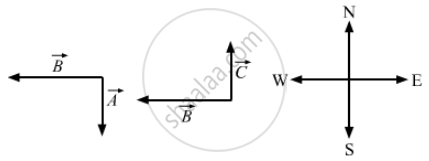Advertisements
Advertisements
Question
Give an example for which \[\vec{A} \cdot \vec{B} = \vec{C} \cdot \vec{B} \text{ but } \vec{A} \neq \vec{C}\].
Solution
To prove:
\[\vec{A} \cdot \vec{B} = \vec{C} \cdot \vec{B,} \text{ but } \vec{A} \neq \vec{C}\]
Suppose that
\[\vec{A}\] is perpendicular to
\[\vec{B};\vec{B}\] is along the west direction.
Also, \[\vec{B}\] is perpendicular to `vecC ; vecA`
\[\vec{C}\] are along the south and north directions, respectively.
`vecA` is perpendicular to \[\vec{B}\], so there dot or scalar product is zero.
i.e .,
\[\vec{A} \cdot \vec{B} = \left| \vec{A} \right|\left| \vec{B} \right|\cos\theta = \left| \vec{A} \right|\left| \vec{B} \right|\cos90^\circ= 0\]
\[\vec{B}\] is perpendicular to \[\vec{C}\], so there dot or scalar product is zero.
i.e., \[\vec{C} \cdot \vec{B} = \left| \vec{C} \right|\left| \vec{B} \right|cos\theta = \left| \vec{C} \right|\left| \vec{B} \right|cos90\ = 0\]
\[\therefore \vec{A} \cdot \vec{B} = \vec{B} \cdot \vec{C,} but \vec{A} \neq \vec{C}\]
Hence, proved.
APPEARS IN
RELATED QUESTIONS
“Politics is the art of the possible”. Similarly, “Science is the art of the soluble”. Explain this beautiful aphorism on the nature and practice of science.
“It is more important to have beauty in the equations of physics than to have them agree with experiments”. The great British physicist P. A. M. Dirac held this view. Criticize this statement. Look out for some equations and results in this book which strike you as beautiful.
What are the dimensions of the ratio of the volume of a cube of edge a to the volume of a sphere of radius a?
If two quantities have same dimensions, do they represent same physical content?
Find the dimensions of frequency .
Find the dimensions of magnetic permeability \[\mu_0\]
The relevant equation are \[F = qE, F = qvB, \text{ and }B = \frac{\mu_0 I}{2 \pi a};\]
where F is force, q is charge, v is speed, I is current, and a is distance.
Find the dimensions of Planck's constant h from the equation E = hv where E is the energy and v is the frequency.
Find the dimensions of the specific heat capacity c.
(a) the specific heat capacity c,
(b) the coefficient of linear expansion α and
(c) the gas constant R.
Some of the equations involving these quantities are \[Q = mc\left( T_2 - T_1 \right), l_t = l_0 \left[ 1 + \alpha\left( T_2 - T_1 \right) \right]\] and PV = nRT.
The height of mercury column in a barometer in a Calcutta laboratory was recorded to be 75 cm. Calculate this pressure in SI and CGS units using the following data : Specific gravity of mercury = \[13 \cdot 6\] , Density of \[\text{ water} = {10}^3 kg/ m^3 , g = 9 \cdot 8 m/ s^2\] at Calcutta. Pressure
= hpg in usual symbols.
Theory of relativity reveals that mass can be converted into energy. The energy E so obtained is proportional to certain powers of mass m and the speed c of light. Guess a relation among the quantities using the method of dimensions.
Which of the sets given below may represent the magnitudes of three vectors adding to zero?
A situation may be described by using different sets coordinate axes having different orientation. Which the following do not depended on the orientation of the axis?
(a) the value of a scalar
(b) component of a vector
(c) a vector
(d) the magnitude of a vector.
Let the angle between two nonzero vectors \[\vec{A}\] and \[\vec{B}\] be 120° and its resultant be \[\vec{C}\].
A vector \[\vec{A}\] makes an angle of 20° and \[\vec{B}\] makes an angle of 110° with the X-axis. The magnitudes of these vectors are 3 m and 4 m respectively. Find the resultant.
Add vectors \[\vec{A} , \vec{B} \text { and } \vec{C}\] each having magnitude of 100 unit and inclined to the X-axis at angles 45°, 135° and 315° respectively.
A spy report about a suspected car reads as follows. "The car moved 2.00 km towards east, made a perpendicular left turn, ran for 500 m, made a perpendicular right turn, ran for 4.00 km and stopped". Find the displacement of the car.
Two vectors have magnitudes 2 m and 3m. The angle between them is 60°. Find (a) the scalar product of the two vectors, (b) the magnitude of their vector product.
Jupiter is at a distance of 824.7 million km from the Earth. Its angular diameter is measured to be 35.72˝. Calculate the diameter of Jupiter.
